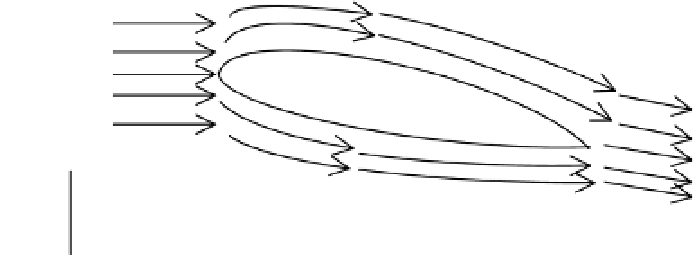Game Development Reference
In-Depth Information
on the air. By Newton's third law of equal and opposite forces, if the airfoil is exerting a force on
the air, then the air is applying an equal and opposite force on the airfoil. The net force on the
airfoil due to air turning, that is, the difference in force between the top and bottom surfaces, is
the lift generated by the airfoil.
Figure 10-6.
Air is turned as it flows over an airfoil.
Another way to describe the lift generated by an airfoil is by using Bernoulli's equation,
first introduced in Chapter 5. If you recall, Bernoulli's equation states that for frictionless,
incompressible (that is, constant density) flow, the sum of the pressure, kinetic energy, and
potential energy is constant.
1
2
p
+
rr
v
2
+
gh
=
const
(10.2)
In Equation (10.2),
p
is the air pressure,
r
is the air density, and
h
is the altitude. If the airfoil
is asymmetric or if it is flying at an angle of attack, the amount of flow turning, and therefore the
flow velocity, will be different over the top and bottom surfaces of the airfoil. According to
Bernoulli's equation, if the velocity is different along the top and bottom surfaces, the pressure
will be different as well. The pressure difference between the top and bottom surfaces is what
generates lift.
The lift generated by an airplane will come primarily from the wings, but some additional
lift is created by the fuselage and by the horizontal stabilizer of the tail. The lift generated by the
horizontal stabilizer is important in maintaining aerodynamic stability, as we will see a little
later in this chapter.
Evaluating Airfoil Lift
To compute the magnitude of the lifting force, the pressure distribution along the top and
bottom surfaces of the airfoil must be calculated. There are two ways to obtain the lift generated
by a given airfoil—the lift can be computed analytically or it can be measured experimentally.
Decades of research have been devoted to coming up with analytical models to predict airfoil
lift. Before the age of computers, analytical methods focused on coming up with mathematical
equations to simulate lift that could be solved directly. An example of such a methodology is
the
thin airfoil theory
in which a three-dimensional airfoil was modeled as a curved, flat plate.
As high-speed computers became available in the 1970s and 1980s, a new methodology
called
computational fluid dynamics
was developed that divided the airfoil into small subsections.







